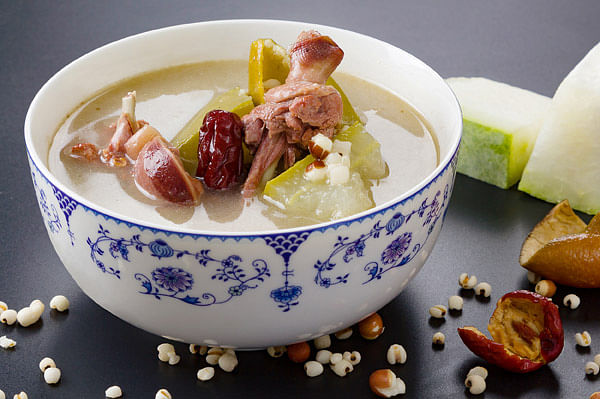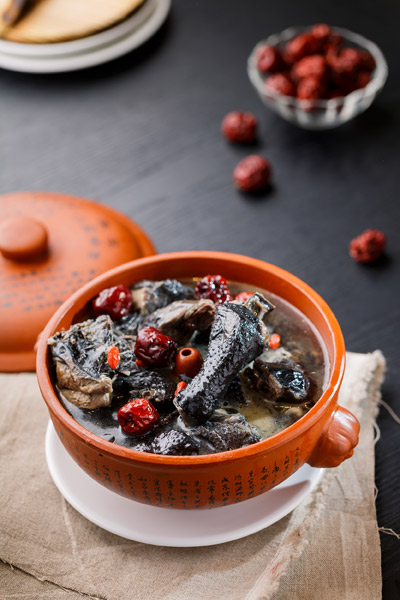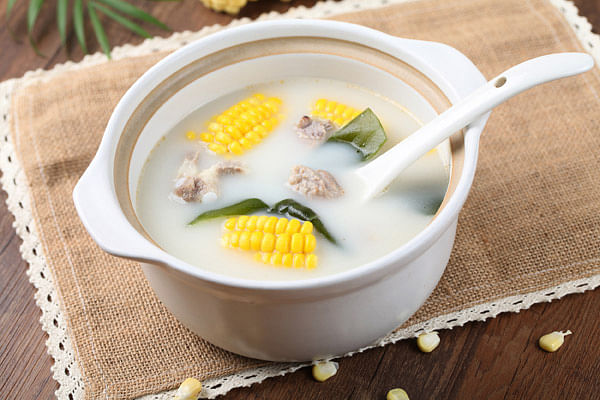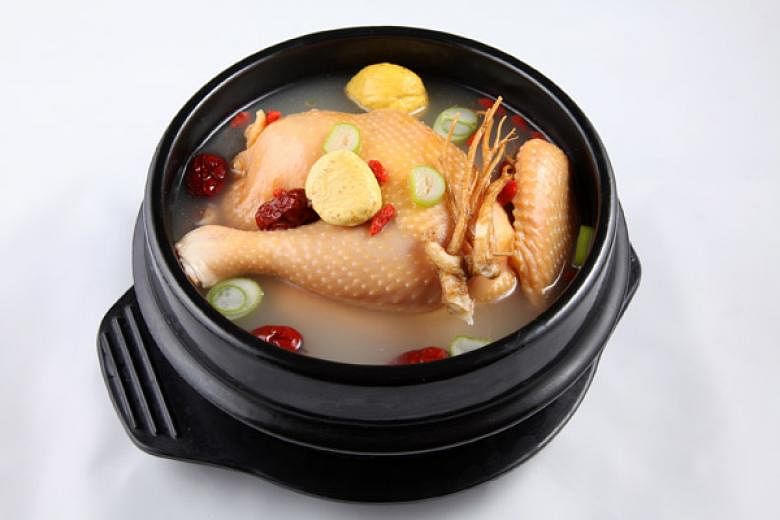(CHINA DAILY/ASIA NEWS NETWORK) - Traditional and fusion cooking styles, regional and international ingredients and a new awareness of healthy eating are all factors contributing to an exciting time for Chinese cuisine.
Heat tires the body. Humidity adds to the stress. When summer days get longer and hotter, the most nourishing meal is a pot of soup, lovingly cooked and full of goodness.
No one understands that better than the Cantonese housewife, who has an encyclopaedic collection of soups for every occasion, and for all weathers.
Summer soups will be light, but full of ingredients that will chase away the effects of humid vapours, such as herbal ingredients like dried Chinese yam, Chinese jujubes, ginseng or angelica root.
Certain ingredients are paired so that one can act as a detox cleanser, while the other replenishes nutrients.
1. Old cucumber pork marrow bones soup
INGREDIENTS
4 big marrow bones, cracked
2 old cucumbers
1/2 cup wolfberries
METHOD
1. Heat a kettle of boiling water and scald the marrow bones. Rinse. Scrub the old cucumbers thoroughly, cut in half lengthwise, remove pith and seeds. Cut into large chunks, leaving the skin on.
2. Heat 2 liters water to a rolling boil and drop the marrow bones in. Add the cucumber chunks. Bring to a boil again and then turn down to a simmer for an hour. Remove any scum that floats.
3. Just before serving, add the wolfberries to the soup and turn off the heat. Season to taste. Keep warm. To serve, ladle one or two cucumber chunks and a marrow bone into the soup bowl, and ladle hot soup over them, adding wolfberries. Salt individually.
Old cucumbers are not your salad cucumbers, allowed to age on the vine, but a different variety, a close cousin. They have a cucumber freshness that infuses the soup, but the flesh cooks to a translucent creaminess. It's a pleasure scooping it up with your soup spoon and allowing it to just slide down the throat.
Old cucumbers are a neutral vegetable, but cooking them with skin on improves their detox factor.
The rich marrow bones combine with the slight alkalinity of the cucumber to create a delicious light emulsion. The wolfberries are not boiled with the soup to preserve their natural sweetness and vitamins. They rehydrate very readily, and in the process, they absorb the flavors of the soup.

2. Winter melon and roasted duck soup
INGREDIENTS
One roast duck carcass, cut into large sections
1kg winter melon
1 large piece ginger, smashed
Cilantro leaves for garnish
METHOD
1. Trim off all visible fat from roast duck pieces. Shave off the skin of the winter melon. Remove pith and seeds, cut into 2-cm chunks. Scrape the skin off the ginger, then rinse and bash with the flat side of a cleaver.
2. Boil water in a clay pot and add the duck, winter melon chunks and ginger. Bring to a boil and then turn down to a simmer for one hour. Remove any scum. Season to taste. Keep warm. Serve garnished with a few coriander leaves.
Duck carcass? Absolutely. This soup stems from a frugal tradition. We used to go out for occasional treats to restaurants serving Peking duck. After enjoying most of the skin and meat, it is a common practice to take home the duck carcass for soup.
Long slow simmering with winter melon makes the duck live again for another day.
If you don't have a habit of dining out on Peking duck, visit your favorite Chinese barbecue shop and ask for roast duck offcuts, like necks, legs and webs. There is an enormous amount of flavor left in these. Or buy half a duck.
Duck is a favorite summer meat, because it is considered "cooling", according to traditional Chinese medicine principles. Winter melon, too, is considered a light diuretic.

3. Black chicken herbal soup
INGREDIENTS
1 black chicken
50g huaishan, dried Chinese yam
50g wolfberries
50g American ginseng, sliced
1 piece ginger, bashed
METHOD
1. Wash the black chicken inside and out. Cut off the tail and trim the fat, especially inside the cavity and around the neck. Drain and keep whole. Stuff the huaishan and wolfberries inside the chicken. Heat up boiling water in a clay pot and add the chicken and ginger.
2. Bring to a boil, then reduce to simmer for an hour. Add the American ginseng slices. Season to taste. Break up the chicken to serve. Garnish with a few dried wolfberries.
The black chicken is actually the silky chicken, a beautiful bird with pure white feathers, red comb and wattle and a bright blue ear patch.
Its skin, and even its bones, are black, a genetic pigmentation. Chinese cooks like using it for soups because it is a lean-muscled bird with little subcutaneous fat.
Chicken will invigorate a body exhausted by heat and humidity. Finally, dried wolfberries can be eaten like raisins. After cooking, they turn mushy, so add a few extra at the end to refresh the taste.

4. Black-eyed peas and catfish soup
INGREDIENTS
100g black-eyed peas, soaked
1 local catfish, gutted and cleaned
50g finely shredded ginger
Small piece rock sugar, about 20g
Salt and pepper
METHOD
1. Soak the black-eyed peas overnight so they cook more easily. Heat up a generous amount of oil in a frying pan and gently saute shredded ginger until golden. Remove the ginger crisps and set aside. Pour off some oil and then sear the cleaned, gutted catfish, browning the skin.
2. Pour boiling water into the pan and keep at a rapid boil until the fish stock turns milky. Pour the stock and fish into a clay pot and top up with more water if necessary. Add the black-eyed peas. Bring to boil and then turn down to a simmer for an hour. Season to taste, adding the rock sugar. Ladle the soup through a sieve into a serving bowl. Garnish with the ginger crisps.
This is an extremely nutritious but easily digested soup fed to recuperating patients. It is also a very typically Shunde soup.
Shunde is situated on the Pearl River Delta, and is built on reclaimed wetlands that were turned into a patchwork of fish ponds. Catfish, or tong sut, is a common enough fish but not a cash crop like the carp reared in the ponds. So it was used whole to make soup.
5. Dried cuttlefish and lotus root soup
INGREDIENTS
300g pork soft cartilage or ribs
300g lotus root or one large segment
1 dried cuttlefish
1 large handful raw peanuts, soaked overnight
2-3 Chinese jujubes (dried red dates)
1 small piece ginger
Salt to taste
METHOD
1. Blanch the pork ribs in boiling water. Peel and clean the lotus root and cut into thick slices. Rinse the cuttlefish and remove the backbone. Break off the tentacles and tear the main piece into two. Rinse the peanuts and red dates, and flatten the ginger with the side of a cleaver.
2. Place a large pot of water to boil, about 3 liters. When it boils, add all the ingredients except the salt. Skim off any foam or scum that rises as the soup comes back to boil, then turn the heat down low to simmer for an hour. When the soup is rich and flavorful, add salt to taste.
3. Take out the lotus roots, soft peanuts and pork ribs and serve them by the side with a soy sauce dip.
This is another Shunde classic that I remember from childhood. It is an incredibly flavorful soup because of the alchemy that happens when cuttlefish meets pork and peanuts. The lotus root simply absorbs all the flavors.
Dried cuttlefish is commonly seen along the southern coastal cities of China. Squid, or cuttlefish, is splayed and dried in the sun, with the heat concentrating all the sweetness as it shrinks and hardens. It actually looks like a miniature kite with its trailing tentacles.
Peanuts, slow cooked, contribute their nutty sweetness to the soup.

